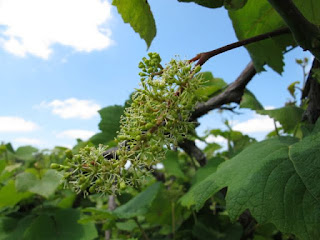–>
I just visited another vineyard down in the south where Norton vines were in full bloom, and when I came back, our Chardonnay vines were in trace-bloom. As we discussed at this year’s VVA meeting, bloom is a very critical time for disease management. Downy mildew, powdery mildew, and black rot tend to show up around this time of the season, and berries will be susceptible to these diseases until 4-6 weeks after bloom. In addition, Botrytis, ripe rot, and bitter rot can cause infection on flowers. Management of Botrytis, ripe rot, and bitter rot at bloom time can be important because these fungi can infect flower, and come back later when berries are maturing.
As you know, development of a disease depends on so many factors such as availability of inoculum (~ disease history), past and future weather conditions, variety, canopy management, etc., thus, I will not go in to details. However, based on the past few weeks of rain events and a trend of warm humid nights we observed, as well as a forecast of thunderstorms during this weekend, it would not be a bad idea to think about downy mildew, since these humid nights can promote spore production of the downy mildew pathogen. Phosphite (= Phosphorous acid) or Metalaxyl (Ridomil) product have a kick-back activity against downy mildew. If your vineyards have a history of black rot, then a DMI material may need to be considered because they have a kick-back activity against black rot. (Of course, since I made these statements, we may not see many rain evens, and may end up not having much of downy or black rot. We will see…) Please refer to either Pest Management Guide or my Workbook for more detailed information on fungicide selection for each disease.
For Botrytis, ripe rot, and bitter rot, please keep in your mind that early season powdery mildew management can become important to prevent these diseases. These pathogens are very good at infecting through wounds; thus, scars, which will turn into opening of the skin, caused by powdery mildew infection on young berries can be the ideal targets for them.

